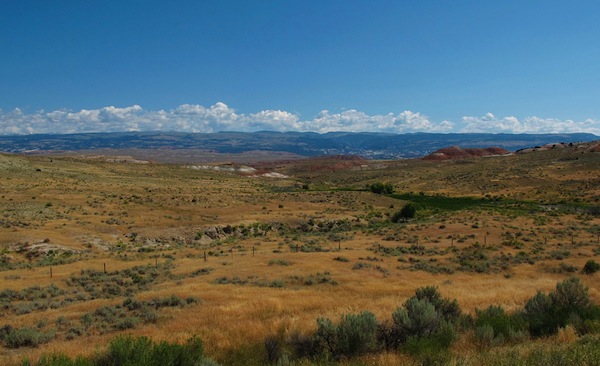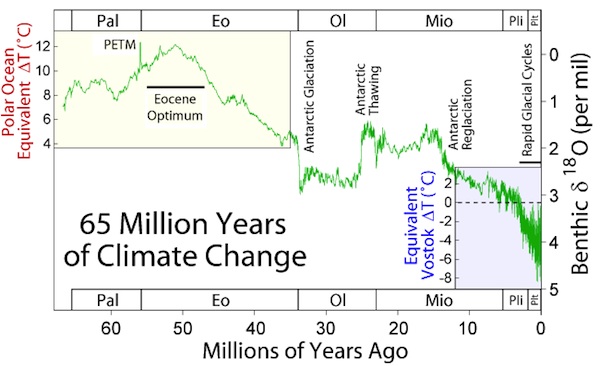What Happened the Last Time the Climate Changed
Smithsonian scientists investigate a sudden warming of the Earth 55 million years ago to understand how climate change will affect future ecosystems
![]()

Wyoming’s Bighorn Basin, where scientists search for fossils to better understand ancient climate change. Image via Dave Bezaire and Susi Havens-Bezaire
In a relatively short time, global emissions of carbon dioxide increased massively. Through the greenhouse effect, they raised temperatures around the planet by an average of 7 to 14 degrees Fahrenheit; they also changed the chemistry of the oceans, triggering a surge in acidity that may have led to mass extinctions among marine life. Overall, during this era of rapid change, global sea levels may have risen by as much as 65 feet.
Reading this, you could be forgiven if you assume we’re talking about a scenario related to the present-day climate crisis. But the previous paragraph actually refers to a 20,000-year-long period of warming that occurred 55 million years ago, an event scientists call the Paleocene-Eocene Thermal Maximum (or PETM for short). Scott Wing, a paleobiologist at the Natural History Museum who has studied the PETM for more than 20 years, says, “If all this sounds familiar, it’s because it’s essentially what we’re doing right now.”
As we embark on an unprecedented experiment with the Earth’s atmosphere and climate, the PETM is suddenly a hot topic among scientists in many disparate fields. “It’s an event that a lot of people are interested in, because it is the best example we have of a really sudden global warming connected to a large release of carbon,” Wing says.
Although scientists still don’t fully understand what triggered the PETM, it is clear that more and more carbon was injected into both the atmosphere and the oceans, initiating the climate change. This carbon may have been supplied by volcanic activity, the spontaneous combustion of peat or even the impact of a particularly carbon-rich comet. Additionally, the initial warming likely led to a release of methane gas from the seafloor, acting as a positive feedback that led to even more climate change. It’s also clear that all this warming wreaked havoc on the world’s ecosystems, leading to extinctions and altering the ranges of numerous plant and animal species.
There is, of course, one key difference: During this previous episode, all that warming took several thousand years. This time, carbon emissions are rising ten times faster than during the PETM, with the warming happening in a century—the geologic equivalent of a blink of an eye.

The sharp uptick in the green line towards the upper-left of this climate chart represents the PETM, the closest analog for our present era of climate change. Image via Wikimedia Commons
Scott Wing researches the PETM by digging for ancient plant remains in Wyoming’s Bighorn Basin. Over several decades of work, he has constructed a general picture of what types of plants thrived before, during and after the warming period, attempting to identify the sorts of trends in plant life we can expect as we change the climate going forward.

A 65-million-year-old leaf cuticle, the sort of specimen used by scientists like Scott Wing to understand the Earth’s ancient climate. Photo by Joseph Stromberg
“During the warm period, essentially none of the plants that had lived in the area previously survived—their local populations were driven extinct,” Wing says. The area had been dominated by ancestors of the types of plants that live in temperate deciduous forests today, such as dogwood, sycamore and redwood trees.
But as the region heated up, these were replaced by a variety of plants related to the present-day bean family, most commonly found in warmer, drier areas such as southern Mexico or Costa Rica. “We believe that what happened is the dispersal into this region of plants that were living somewhere else, probably much farther south,” says Wing. His team has also uncovered evidence that the warmer climate led to a greater level of insect pest damage on the plants that did survive the PETM.
His research has, however, turned up one trend from the PETM that could be a reason to hope ecosystems can someday rebound from climate change. After roughly 200,000 years, long after the PETM subsided and temperatures returned to normal, many of the temperate plants that had lived in the Bighorn Basin finally returned.
“One possible explanation,” Wing says, “is that there were cooler climates in the nearby mountains that served as refuges for these species.” In that scenario—one that he and his research team plan to more closely investigate as they continue to excavate and piece together the fossil record—these types of plants would have waited out the PETM in the relatively cold highlands, then returned to recolonize the basin afterward.
If our climate continues to change as rapidly as it has over the past few decades, though, such a scenario seems less likely—immobile organisms such as plants need hundreds of years to gradually migrate from one area to another. Thus, one key aspect of preserving our planet’s ecosystems, in addition to limiting climate change as much as possible, is slowing it down as much as we can.
/https://tf-cmsv2-smithsonianmag-media.s3.amazonaws.com/accounts/headshot/joseph-stromberg-240.jpg)
/https://tf-cmsv2-smithsonianmag-media.s3.amazonaws.com/accounts/headshot/joseph-stromberg-240.jpg)